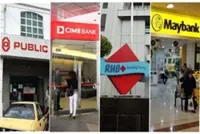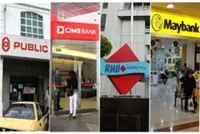Market unease: A farmer trims a cocoa tree at a plantation in Tanjung Rejo, Lampung province, Indonesia. A senior economist flags potential non-performing loans spikes from the proposed cooperative lending policy. — AP
JAKARTA: Indonesia’s state-owned lenders are facing fresh financial risks as President Prabowo Subianto moves forward with a massive plan to establish 70,000 to 80,000 village cooperatives nationwide, funded by a mix of village funds and bank loans.
The initiative, which would channel up to 400 trillion rupiah in funding, is expected to put pressure on state banks Bank Rakyat Indonesia (BRI), Bank Mandiri, Bank Negara Indonesia (BNI) and Bank Tabungan Negara, raising concerns over a potential rise in nonperforming loans (NPLs) and liquidity strains.
Doddy Ariefianto, a banking analyst at Binus University, said forcing state banks to funnel hundreds of trillions of rupiah to newly established cooperatives “is theoretically possible but practically unsound”.
Distinct from traditional business structures, he argued that no cooperative has yet demonstrated a viable and profitable model worthy of this funding scale, especially given the many previous cases of fraud and defaults.
Doddy argued that even BRI, specialising in micro, small and medium enterprises (MSMEs) lending, could not handle these kinds of financing.
“State-owned banks don’t have spare liquidity to finance MSMEs at scale, let alone cooperatives, which aren’t their core business,” Doddy said.
Banks could push back by rejecting risky loan applications just as they would with any other proposals, Doddy noted.
But in the end, “it may all come down to a political showdown between state bank executives and the government”, he added.
Each cooperative would receive up to five billion rupiah concessional loans from state-owned banks with up to five years of repayment terms, Home Minister Tito Karnavian told reporters on March 7 after a closed-door meeting with President Prabowo.
The plan will be officially launched in mid-July. Absorbing local agricultural produce and simplifying food distribution chains would be among the tasks of these institutions, Cooperatives Minister Budi Arie Setiadi said on the same day.
Budi added this could boost the economy in villages.
Indonesia’s cooperative movement has a long history, with one of the country’s founding fathers once envisioning these institutions as the nation’s main economic platform.
Yet, many cooperatives have experienced poor management and performance, while a few have been involved in embezzlement.
The government estimates that there were over 130,000 cooperatives in 2023, down from over 209,000 a decade earlier, due to many disbandments.
Fitch Ratings financial institution directors Lucky Ariesandi and Willie Tanoto warned that state bank credit profiles could be undermined by direct lending to untested cooperatives with insufficient collateral, a risk that could escalate with rising lending volumes.
“Such lending could weigh on their risk profiles and asset quality, depending on the level of credit exposure and risk mitigation measures,” the two wrote on March 11.
Other government-led programmes like financing affordable housing could also mark a major shift in business strategy, particularly for banks like Mandiri and BNI, they added, which have traditionally focused on corporate lending.
BRI chief executive officer Sunarso said that he expected loan repayments would come from village funds, estimated at two trillion rupiah annually.
“The banks would be safe, because repayments will come from village funds,” Sunarso said, as quoted by Bisnis.
The Finance Ministry has set the 2025 village funds at 71 trillion rupiah, with 69 trillion rupiah from prior calculations and two trillion rupiah added this year.
A BRI Danareksa Sekuritas report released on March 10 warned that the village cooperative plan would add downside risks to banks’ earnings.
In a worst-case scenario, state-owned banks could see their credit costs jump by 49 to 82 basis points, and earnings could drop 11% to 56%.
If banks were required to fund the loans internally, this could potentially squeeze liquidity by locking up 5% to 9% of their current deposits.
The previous administration of President Joko “Jokowi” Widodo had also initiated a microloans programme over the past decade, involving state-run banks in the process, with many still ongoing.
Rully Arya Wisnubroto, a senior economist at local brokerage Mirae Asset Sekuritas, flagged potential NPL spikes from the proposed cooperative lending policy.
He said this could trigger negative market sentiment towards state-owned banks.
According to rating agency Pefindo, loans to cooperatives carry an NPL rate of 8.5%, which is significantly higher than the banking sector’s overall NPL ratio of around 2%.
“We must be very cautious,” Rully said, adding that rising NPL ratios would erode bank profitability and force substantial reserve allocations.
Before the cooperative financing programme, market pressure had mounted on Bank Mandiri, BNI and BRI, the three largest state-run banks slated for control by the country’s newly established sovereign wealth fund Danantara.
Foreign investors dumped US$266mil in Bank Mandiri shares in February, the largest sell-off since 2020.
This market unease intensified during Danantara’s late February launch, triggering a sharp decline in large-cap state bank share prices and briefly sending the Jakarta Composite Index into a tailspin.
Village heads across the country have rejected the plan, calling it poorly conceived and a potential burden on villages, and they are threatening to conduct a protest if the government keeps pushing ahead with the initiative.
Cooperatives Minister Budi Arie Setiadi dismissed concerns regarding the programme.
He said that the government promised strict law enforcement against fund misappropriation. — The Jakarta Post/ANN





